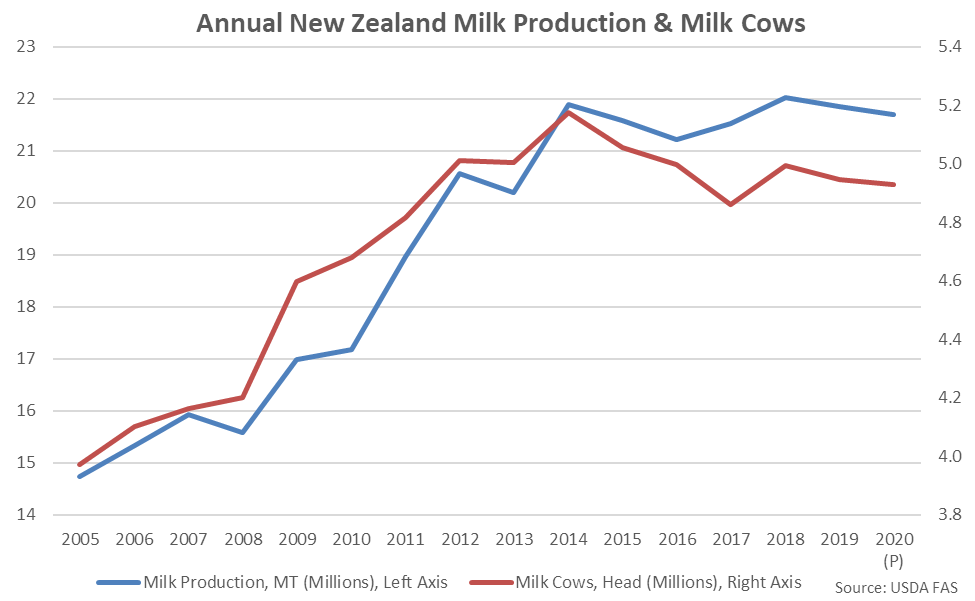Highlights from the updated report include:
- New Zealand milk production volumes increased 1.7% on a YOY basis during Sep ’20, reaching a six year high seasonal level.
- Fonterra’s ’20-’21 farmgate milk price forecast of $6.30-$7.30/kgMS was revised $0.40/kgMS higher throughout Oct ’20 on improved Chinese demand. The ’20-’21 farmgate milk price forecast remained below the six year high level experienced throughout the previous production season at the midpoint of the estimate, however.
- New Zealand cow & heifer slaughter rates declined 0.3% on a YOY basis during Sep ’20 when normalizing for slaughter days, finishing lower for the first time in the past four months.
Additional Report Details Milk Production According to Dairy Companies Association of New Zealand (DCANZ), Sep ’20 New Zealand milk production volumes finished 1.7% higher on a YOY basis, reaching a six year high seasonal level. On a milk-solids basis, production increased 1.8% YOY, also reaching a six year high seasonal level. 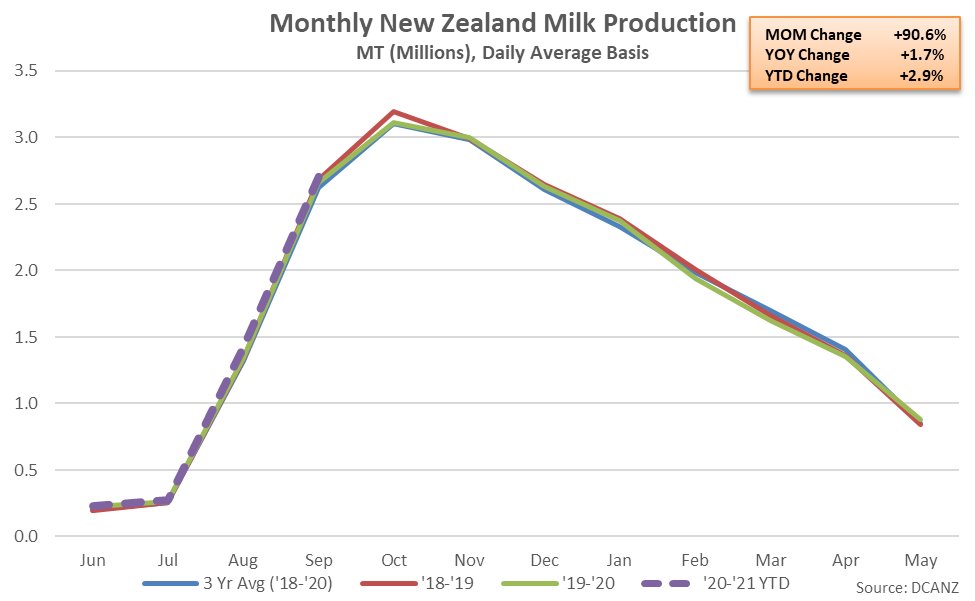 The Sep ’20 YOY increase in New Zealand milk production volumes was the fifth experienced in a row but the smallest experienced over the five month period. ’19-’20 annual milk production volumes declined 0.7% on a YOY basis however production on a milk-solids basis increased 0.3% YOY throughout the period. Drought conditions impacted the milk supply throughout the ’19-’20 production season. ‘20-’21 YTD New Zealand milk production volumes have rebounded by 2.9% on a YOY basis throughout the first third of the production season.
The Sep ’20 YOY increase in New Zealand milk production volumes was the fifth experienced in a row but the smallest experienced over the five month period. ’19-’20 annual milk production volumes declined 0.7% on a YOY basis however production on a milk-solids basis increased 0.3% YOY throughout the period. Drought conditions impacted the milk supply throughout the ’19-’20 production season. ‘20-’21 YTD New Zealand milk production volumes have rebounded by 2.9% on a YOY basis throughout the first third of the production season. 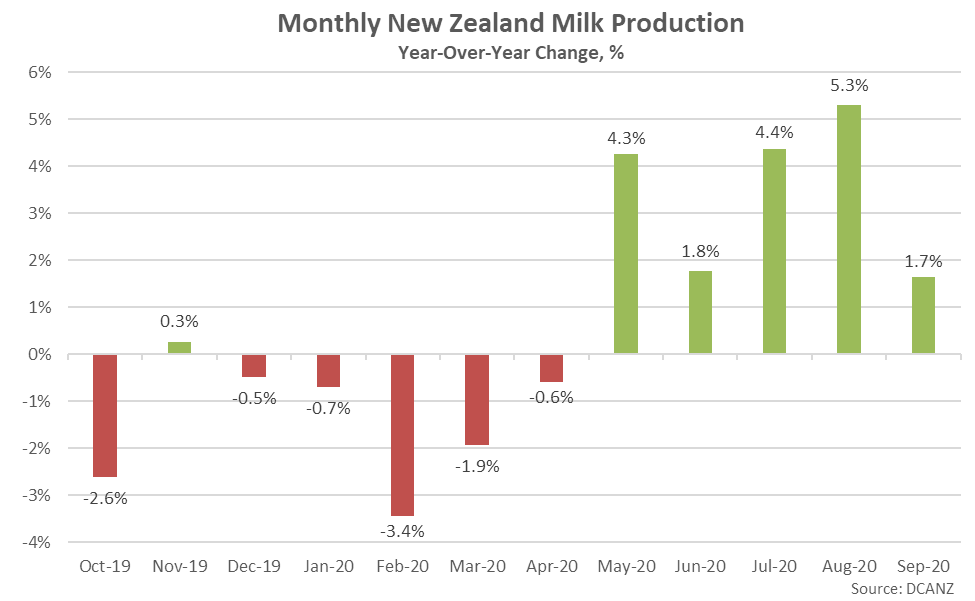 Rainfall & Soil Moisture Deficits New Zealand rainfall remained below previous year levels for the third consecutive month throughout Sep ’20 but finished above long-term historical seasonal figures. Rainfall levels finished 0.8% below the previous year but remained 12.9% above 20 year average seasonal levels for the month of September. Sep ’20 rainfall throughout the South Island of New Zealand reached a ten year seasonal high level however rainfall levels experienced throughout the North Island finished at the second lowest seasonal level experienced throughout the past nine years.
Rainfall & Soil Moisture Deficits New Zealand rainfall remained below previous year levels for the third consecutive month throughout Sep ’20 but finished above long-term historical seasonal figures. Rainfall levels finished 0.8% below the previous year but remained 12.9% above 20 year average seasonal levels for the month of September. Sep ’20 rainfall throughout the South Island of New Zealand reached a ten year seasonal high level however rainfall levels experienced throughout the North Island finished at the second lowest seasonal level experienced throughout the past nine years. 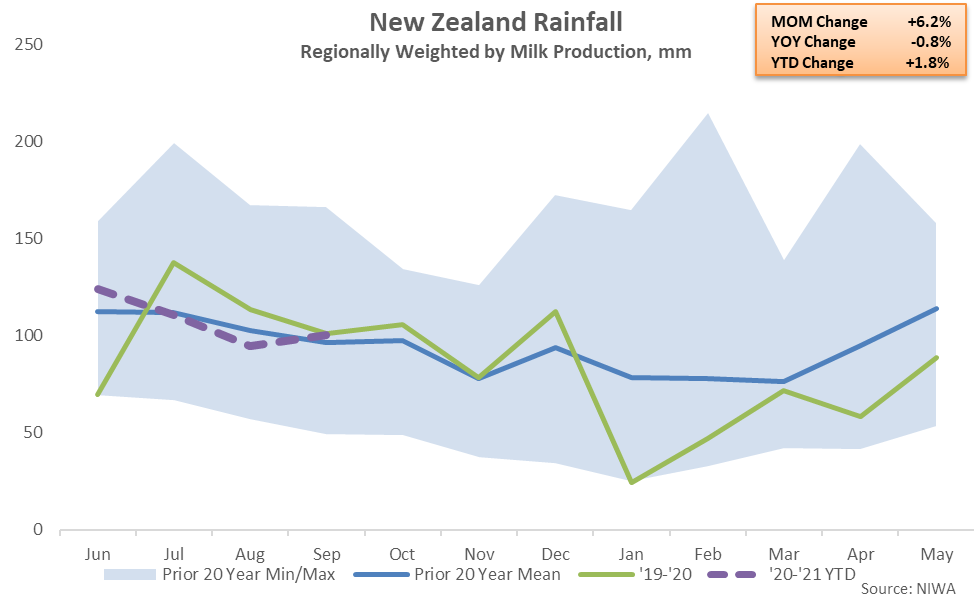 Reduced rainfall levels experienced throughout the past few months have resulted in New Zealand soil moisture deficits reaching a six year seasonal high level for the month of September. Soil moisture deficits remained near seasonal low levels, however, and do not historically begin to accelerate significantly for the next several months.
Reduced rainfall levels experienced throughout the past few months have resulted in New Zealand soil moisture deficits reaching a six year seasonal high level for the month of September. Soil moisture deficits remained near seasonal low levels, however, and do not historically begin to accelerate significantly for the next several months. 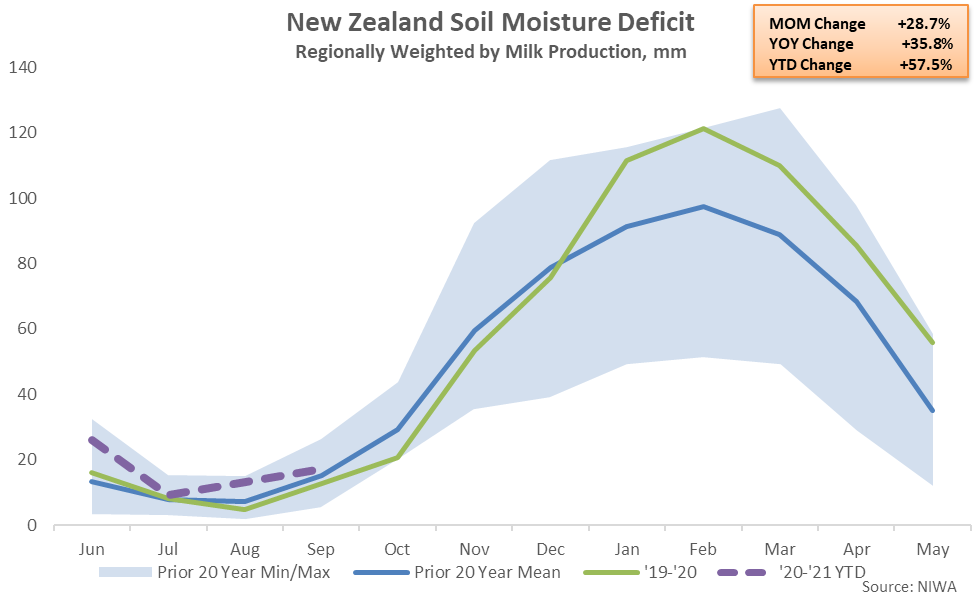 Farmgate Milk Prices Fonterra finalized their ’19-’20 farmgate milk price at a value of $7.14/kgMS in Sep ’20, reaching a six year high level. Fonterra’s ’20-’21 farmgate milk price forecast was revised $0.40/kgMS higher at the midpoint during Oct ’20, reaching a range of $6.30-$7.30/kgMS. Fonterra stated the ’20-’21 farmgate milk price forecast was revised higher largely due to improved Chinese demand. Fonterra’s ’20-’21 farmgate milk price forecast range remains historically wide as significant uncertainties remain surrounding the impact of COVID-19 on global demand.
Farmgate Milk Prices Fonterra finalized their ’19-’20 farmgate milk price at a value of $7.14/kgMS in Sep ’20, reaching a six year high level. Fonterra’s ’20-’21 farmgate milk price forecast was revised $0.40/kgMS higher at the midpoint during Oct ’20, reaching a range of $6.30-$7.30/kgMS. Fonterra stated the ’20-’21 farmgate milk price forecast was revised higher largely due to improved Chinese demand. Fonterra’s ’20-’21 farmgate milk price forecast range remains historically wide as significant uncertainties remain surrounding the impact of COVID-19 on global demand. 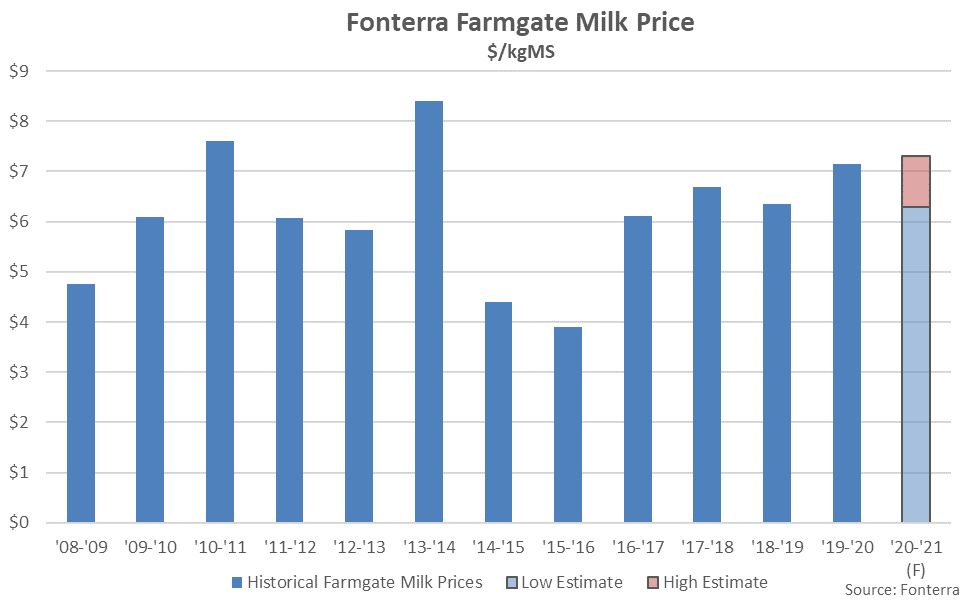 Cow & Heifer Slaughter New Zealand cow & heifer slaughter rates declined 0.3% on a YOY basis during Sep ’20 when normalizing for slaughter days, finishing lower for the first time in the past four months. Sep ’20 dairy cow & heifer slaughter, which has more limited historical data available, also declined on a YOY basis for the first time in the past four months, finishing down 3.1%. ’19-’20 annual New Zealand cow & heifer slaughter rates rebounded 2.7% from the previous year, reaching a four year high level. ’20-’21 YTD New Zealand cow & heifer slaughter rates have increased by an additional 8.0% on a YOY basis throughout the first third of the production season, despite the most recent decline.
Cow & Heifer Slaughter New Zealand cow & heifer slaughter rates declined 0.3% on a YOY basis during Sep ’20 when normalizing for slaughter days, finishing lower for the first time in the past four months. Sep ’20 dairy cow & heifer slaughter, which has more limited historical data available, also declined on a YOY basis for the first time in the past four months, finishing down 3.1%. ’19-’20 annual New Zealand cow & heifer slaughter rates rebounded 2.7% from the previous year, reaching a four year high level. ’20-’21 YTD New Zealand cow & heifer slaughter rates have increased by an additional 8.0% on a YOY basis throughout the first third of the production season, despite the most recent decline. 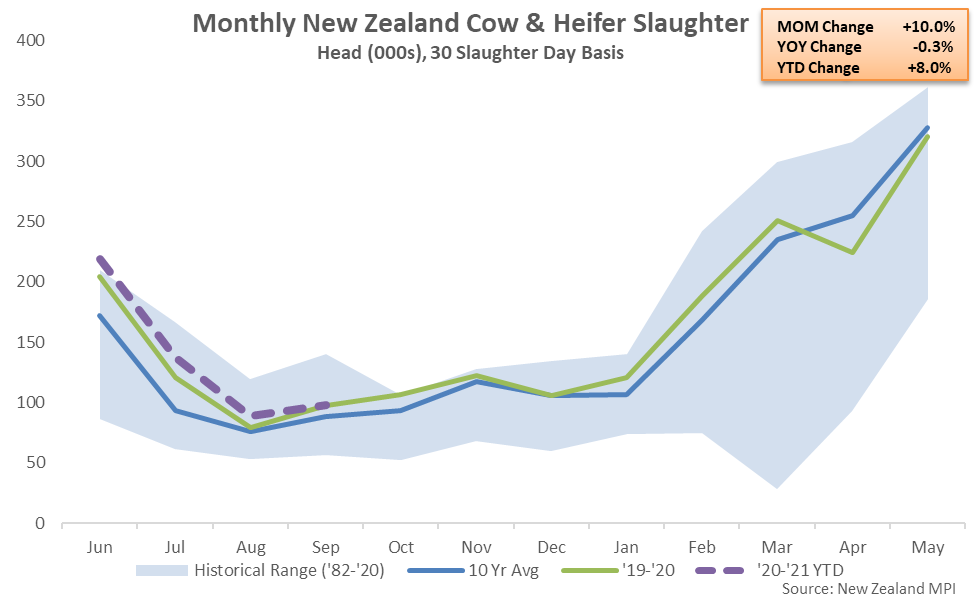 New Zealand milk production volumes increased at a compound annual growth rate of 4.2% over the ten year period ending during the ’14-’15 record production season but have trended flat-to-lower over the four most recent production seasons as farmgate milk prices declined from the ’13-’14 record high levels and the New Zealand milk cow herd was reduced. USDA is projecting the New Zealand milk cow herd will decline slightly on a YOY basis throughout 2020 but remain above the six year low level experienced throughout 2017.
New Zealand milk production volumes increased at a compound annual growth rate of 4.2% over the ten year period ending during the ’14-’15 record production season but have trended flat-to-lower over the four most recent production seasons as farmgate milk prices declined from the ’13-’14 record high levels and the New Zealand milk cow herd was reduced. USDA is projecting the New Zealand milk cow herd will decline slightly on a YOY basis throughout 2020 but remain above the six year low level experienced throughout 2017. 